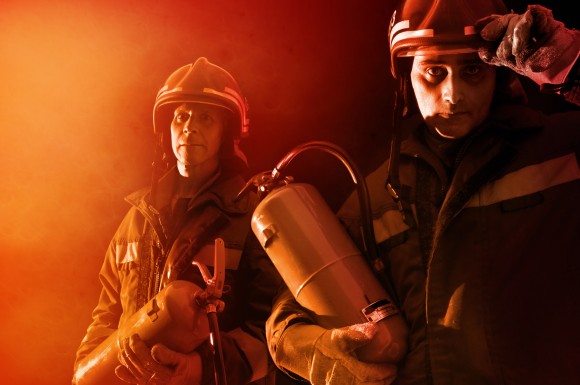When it comes to saving property and lives the nation’s volunteer firefighters are often the first line of defense.
Volunteers make up a majority of the nation’s firefighters — some 69 percent of firefighters in the United States. Of the total estimated 1,129,250 volunteer and paid firefighters across the country, 783,300 are volunteers, according to the National Volunteer Fire Council.
Communities served by volunteer firefighters depend on them for many types of emergencies, not just fires. Volunteer firefighters respond every day to situations arising from fires, emergency medical incidents, terrorist events, natural disasters, hazardous materials incidents, water rescue emergencies and many more.
It doesn’t get any better from a volunteerism standpoint than how volunteer firefighters serve their communities, said Lisa Parry Becker, an independent agent with William B. Parry & Son Ltd., who lives and works in the suburban Philadelphia area.
Parry Becker, whose agency has been specializing in insuring volunteer fire departments and other emergency service organizations for about 15 years, is thankful for the service many of her clients provide.
“Some of the fire departments we insure have volunteers that take the train every day to work in New York City, and then come home and fight fires at night,” she said. “We all need to be thankful for what they do for us day-in and day-out.”
The time alone saves billions. According to the National Volunteer Fire Council, volunteer time donated by firefighters saves localities across the country an estimated $139.8 billion per year. That figure doesn’t include the savings to property and life these volunteers help to support.
One insurance market that has been serving volunteer fire departments for nearly four decades is VFIS, a division of Glatfelter Insurance Group.
VFIS is one of the largest providers of insurance, education and consulting services for emergency service organizations such as fire departments, ambulance and rescue squads, and 911 centers.
“We originally started out in 1969 insuring volunteer fire departments with accident and sickness products, where we insured a loss of life benefit and a couple other things,” said Troy Markel, president of VFIS in York, Pa. Eventually, in the early ’70s, VFIS expanded into the property/casualty side of the business, Markel said. “We also added the Length of Service Awards Program (LOSAP), which is a life insurance program. Then we also have a group term product in addition to a critical illness product. In total we have five different products within VFIS that we can sell to emergency service organizations.”
Over the years, Markel said the VFIS program’s growth has tracked well with the commercial marketplace and has remained stable.
“We’ve been in it so long that we have a pretty good idea as to where the exposures are or aren’t,” he said.
The segment is also ideal for the program business market because most volunteer fire departments and other emergency service organizations operate in a similar fashion and present similar exposures.
VFIS’s property/casualty coverage has been underwritten through American Alternative Insurance Corp., an admitted affiliate of Munich Reinsurance America Inc., since 1986. The program’s accident and sickness coverage has been underwritten through National Union Fire Insurance Co. of Pittsburgh, Pa., an AIG company, for more than 30 years.
Markel said that success in this niche market relies on specialization and expertise. In their former careers many VFIS employees worked as paramedics and firefighters, both as career and volunteer firefighters, before joining VFIS.
“A large number of our claims staff in addition to some of our underwriting staff and even our sales executives, education and training folks, and our risk control folks have an emergency service background,” Markel said.
That expertise makes working with specialists in this class critical, said Parry Becker. “They make it easy because many of the underwriters were fire department personnel.” It makes the claims settlement process so much better, she added.
While fighting fires is likely one of the more dangerous jobs to hold, the insurance market for volunteer fire departments remains stable when it comes to claims history. Markel credits that to the industry’s focus on safety.
There is a high risk opportunity for catastrophic injury, Markel said, but safety practices within the fire industry continuously evolve and improve.
Both Markel and Parry Becker said that most claims in this segment arise from traditional commercial business exposures.
Normal property claims, such as burst pipes in the winter months, or small commercial auto accidents, are typical, Parry Becker said. “We had one inland marine claim where the fire inspector was taking pictures with a fire department camera and the camera fell and dropped into fire debris and melted,” she said. “You don’t see that every day!”
Parry Becker has found this niche to be very stable.
“If the organization experiences high claim frequency then it’s appropriate to charge for that,” she said. “But in terms of rating it’s been very consistent year over year.”
Was this article valuable?
Here are more articles you may enjoy.



 AIG General Insurance Chairman McElroy to Retire May 1
AIG General Insurance Chairman McElroy to Retire May 1  Chubb to Acquire MGA Healthy Paws From Aon
Chubb to Acquire MGA Healthy Paws From Aon  Why New York’s Attorney General Objects to Trump’s Bond Insurer
Why New York’s Attorney General Objects to Trump’s Bond Insurer  FBI Says Chinese Hackers Preparing to Attack US Infrastructure
FBI Says Chinese Hackers Preparing to Attack US Infrastructure 



